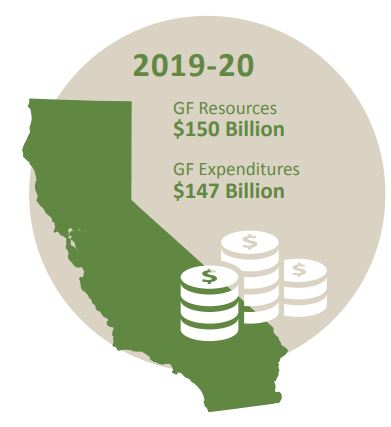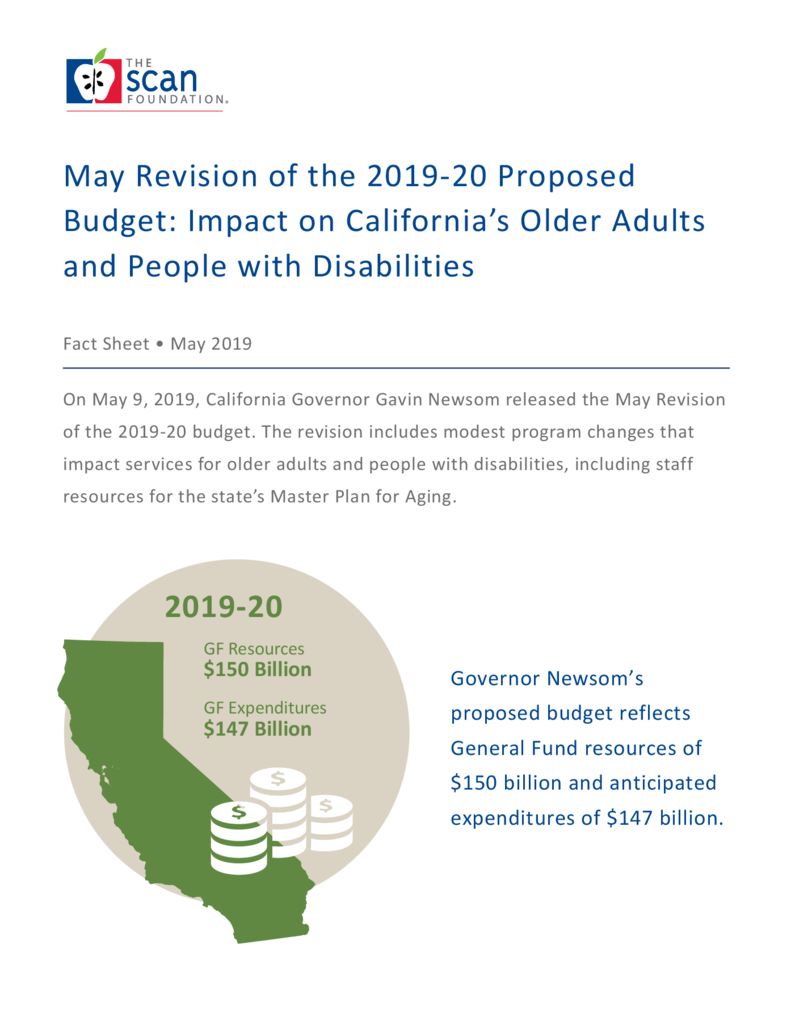May Revision of the 2019-20 Proposed Budget: Impact on California’s Older Adults and People with Disabilities
summary
On May 9, 2019, California Governor Gavin Newsom released the May Revision of the 2019-20 budget. The revision includes modest program changes that impact services for older adults and people with disabilities, including staff resources for the state’s Master Plan for Aging.
Date Updated: 05/15/2019Overview
On May 9, 2019, Governor Gavin Newsom released an updated budget forecast for the 2019-20 budget,referred to as the “May Revision,” which accounts for changes in revenues and proposed changes to expenditures from the January budget. The May Revision projects a revenue increase of $3.2 billion General Fund (GF) above the governor’s proposed budget, and includes an increase of $2.8 billion GF in new spending with investments in developmental services, early education, disaster preparedness, health care, school workforce, and homelessness programs.1,2 Additionally, the May Revision proposes to expand the January budget’s Earned Income Tax Credit proposal and eliminate the sales tax on selected hygiene products for women and children. There are no new significant expenditures specific to services for older adults.

Governor Newsom’s proposed budget reflects General Fund resources of $150 billion and anticipated expenditures of $147 billion.
The May Revision reflects total GF resources of $150 billion GF and anticipated expenditures of $147 billion GF, with the rest held in reserve. The May Revision reflects a Budget Stabilization Account* balance of $16.5 billion, a Safety Net Reserveᵻ balance of $1.6 billion, and plans to address the state’s debts, deferrals, and retirement liabilities.1
New Investments in the May Revision
The May Revision includes the following new investments impacting older adults and people with disabilities:
- Master Plan for Aging Staffing Resources: The May Revision includes $873,000 GF and six positions to support several new projects under the governor’s leadership, including the Master Plan for Aging, the Alzheimer’s Prevention and Preparedness Task Force, and the Single-Payer Commission.4
- Restoration of Medi-Cal Optician and Optical Lab Services: The May Revision allocates $11.3 million from Proposition 56 funding to restore optician and optical lab services for adult beneficiaries in the Medi-Cal program, effective no sooner than January 1, 2020. This funding will sunset December 31, 2021.1
Updates to the Governor’s Proposed 2019-20 Budget
The following items impacting older adults and people with disabilities were included in the governor’s January budget proposal, with modifications specified in the May Revision.
- In-Home Supportive Services (IHSS): The IHSS program provides in-home personal assistance to low-income adults who are age 65 and older, blind, or disabled, and to children who are blind or disabled. Services include assistance with bathing, feeding, dressing, and/or domestic services such as shopping, cooking, and housework so that individuals can remain safely in their own homes.
The January budget estimated that IHSS would serve approximately 564,000 individuals in 2019-20, dedicating $12.7 billion ($4.3 billion GF) for the IHSS program.5 Due to increases incaseload growth, average hours per case and average cost per case, the May Revision includes an additional $60.5 million GF in 2018-19 and $151.6 million GF in 2019-20 for IHSS.1 The following proposals included in the January budget have been modified as follows:
-
- Restoration of service-hour reductions: The January budget proposed to permanently restore the 7 percent across-the-board reduction in service hours applied in 2012, starting July 1, 2019.5 Instead, the May Revision proposes to temporarily restore the 7 percent reduction through December 31, 2021, due to lower revenue forecasts than expected.1 The May Revision includes an increase of $15.3 million GF to reflect the updated costs for the temporary restoration of the 7 percent reduction.
- County IHSS maintenance-of-effort: The January budget revised the IHSS county-state funding formula methodology negotiated in 2017, reducing county IHSS expenditures and increasing state costs by $241.7 million GF in 2019-20. In future years, when a county negotiates hourly wages above the targeted minimum hourly wage of $15, the nonfederal share of cost will be split—with the county paying 65 percent and the state paying 35 percent.5 The May Revision increases the county IHSS maintenance-of-effort by $55 million GF based on revised revenue and cost projections, as well as revised IHSS caseload projections.1
- Electronic visit verification: Under federal law, states are required to implement an electronic visit verification system for personal care services by January 1, 2020, and for home health services by January 1, 2023. The January budget included $34.9 million ($5.3 million GF) for implementation.5 The May Revision does not modify this proposal.
- SSI/SSP: The Supplemental Security Income, or SSI (a federal program that provides a monthly cash benefit to low-income aged, blind, and disabled individuals) is augmented with a State Supplementary Payment (SSP) grant. In 2019, maximum SSI/SSP grant levels are $931 per month for individuals and $1,564 per month for couples.5 Per the January budget, SSI/SSP payments will increase to $950 per month for individuals and $1,593 per month for couples in 2020.5 Estimating that 1.22 million people would receive monthly benefits in 2019-20, the governor’s proposed budget included $2.75 billion GF for SSI/SSP.5 The May Revision decreases total SSI/SSP expenditures by $5.9 million GF in 2018-19 and $18 million GF in 2019-20 to reflect updated caseload and average cost per case projections.1 Other adjustments include:
- Elimination of the SSI cash-out policy: The 2018-19 budget expanded CalFresh (California’s Supplemental Nutrition Assistance Program) eligibility to SSI recipients who had previously been prohibited from participating in the program. Prior to the policy change, SSI/SSP recipients had received a monthly $10 supplement in lieu of CalFresh benefits. Additionally, when households with an SSI/SSP recipient applied for CalFresh, the SSI/SSP income was not included as part of the household income for the eligibility determinations. This is no longer the case. To address the loss of food benefits resulting from this policy change, the 2018-19 budget included one-time funds for affected families. The 2019-20 January budget included $86.7 million GF and makes the offset permanent.5 The May Revision includes a one-time increase of $15 million GF in 2019-20 for county administrative costs related to processing new CalFresh applicants.1
- SSI advocacy: The Housing and Disability Advocacy Program assists disabled homeless individuals with applying for disability benefit programs. The January budget included $25 million GF on an ongoing basis to continue implementing this program.5 The May Revision does not modify this proposal.
- Alzheimer’s Disease Program Grant Awards: The January Budget included $3 million GF annually to support Alzheimer’s disease research, and to create a governor’s Alzheimer’s Prevention and Preparedness Task Force. The May Revision does not modify this proposal, but includes additional staffing resources (see above).5,7
- Whole Person Care Pilot: Established through the 1115 Waiver, the Whole Person Care Pilot program is a federal/state partnership that coordinates health, behavioral health, and social services. The January budget proposed a one-time augmentation of $100 million GF available for use through June 2025. The May Revision includes one-time expenditure of $20 million from the Mental Health Services Fund over five years for counties that currently do not operate Whole Person Care Pilots.1,6
- Traumatic Brain Injury Program: The proposed budget included $1.2 million GF for the program, establishing a more sustainable funding source by switching from the State Penalty Fund to GF.5 The May Revision does not modify this proposal.
Next Steps in the Budget Process
Budget subcommittees will review the governor’s May Revision and schedule hearings through the end of May. Each subcommittee will vote on budget items contained within its respective issue area(s) and submit a report for vote in the full budget committee. Next, the full membership of the Senate and Assembly will vote on the full budget bill. Each chamber’s budget bill will be referred to a joint budget conference committee where differences between the Senate and Assembly versions will be resolved. The Conference Committee then votes on the proposed version, which, if passed, is sent to the floor of the Assembly and Senate simultaneously. By law, the Legislature must approve the budget by June 15.The governor has the authority to “blue pencil” (reduce or eliminate) any appropriation contained in the budget prior to signing it by July 1, 2019.8,9
Key Budget Dates
June 15, 2019 – Deadline for Legislature to approve final budget
July 1, 2019 – Deadline for governor to sign the budget
Download the publication for all visuals and complete references.
Continue Reading
This policy brief provides an introduction to The SCAN Foundation’s CLASS Technical Assistance Brief Series, which explores many of the critical issues to be considered for successfully implementing CLASS.
This policy brief describes the broad needs of individuals with disability and the wide range of supportive and environmental solutions that can allow for the most independent living possible. It suggests how findings on social and environmental supports for individuals with disability can inform implementation of CLASS.
This policy brief provides background on the historical development of benefit eligibility triggers in the private long-term care insurance market. Understanding how these triggers came into being can provide important information to those charged with implementing the CLASS Plan.


